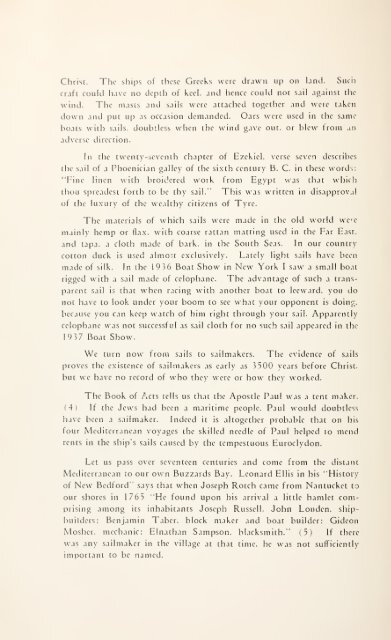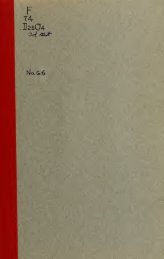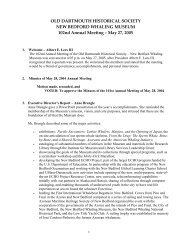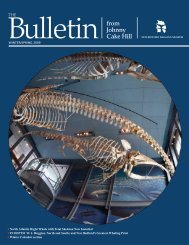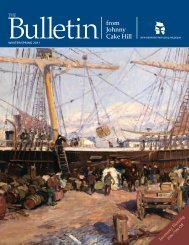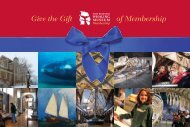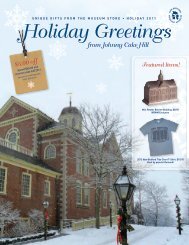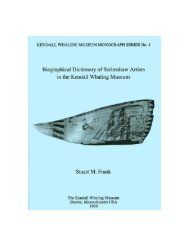Old Dartmouth historical sketches - New Bedford Whaling Museum
Old Dartmouth historical sketches - New Bedford Whaling Museum
Old Dartmouth historical sketches - New Bedford Whaling Museum
You also want an ePaper? Increase the reach of your titles
YUMPU automatically turns print PDFs into web optimized ePapers that Google loves.
Christ. Tin- ships of these Greeks were drawn up on land. Such<br />
craft could have no depth of keel, and hence could not sail against the<br />
wind. The masts and sails were attached together and were taken<br />
down and put up as occasion demanded. Oars were used in the same<br />
boats with sails, doubtless when the wind gave out. or blew from an<br />
adverse direction.<br />
the sail<br />
In the twenty-seventh chapter of Ezckiel. verse seven describes<br />
of a Phoenician galley of the sixth century B. C. in these words:<br />
"Fine linen with broidcred work from Egypt was that which<br />
thou spreadest forth to be thy sail." This was written in disapproval<br />
of the lu.xury of the wealthy citizens of Tyre.<br />
The materials of which sails were made in the old world we-^c<br />
mainly hemp or flax, with coarse rattan matting used in the Far East,<br />
and tapa. a cloth made of bark, in the South Seas. In our country<br />
cotton duck is used almost exclusively. Lately light sails have been<br />
made of silk. In the 19 36 Boat Show in <strong>New</strong> York I saw a small boat<br />
rigged with a sail made of celophanc. The advantage of such a transparent<br />
sail is that when racing with another boat to leeward, you do<br />
not have to look under your boom to sec what your opponent is doing,<br />
because you can keep watch of him right through your sail.<br />
Apparently<br />
cclophane was not successful as sail cloth for no such sail appeared in the<br />
1937 Boat Show.<br />
We turn now from sails to sailmakcrs. The evidence of sails<br />
proves the existence of sailmakers as early as 3 500 years before Christ,<br />
but we have no record of who they were or how they worked.<br />
The Book of Acts tells us that the Apostle Paul was a tent maker.<br />
(4 I If the Jews had been a maritime people. Paul would doubtless<br />
have been a sailmaker. Indeed it is altogether probable that on his<br />
four Mediterranean voyages the skilled needle of Paul helped to mend<br />
rents in the ship's sails caused by the tempestuous Eurodydon.<br />
Let us pass over seventeen centuries and come from the distant<br />
Mediterranean to our own Buzzards Bay.<br />
Leonard Ellis in his "History<br />
of <strong>New</strong> <strong>Bedford</strong>" says that when Joseph Rotch came from Nantucket to<br />
our shores in 1765 "He found upon his arrival a little hamlet comprising<br />
among its inhabitants Joseph Russell. John Louden, shipbuilders:<br />
Benjamin Tabcr. block maker and boat builder: Gideon<br />
Mosher. mechanic: Elnathan Sampson, blacksmith." (5) If there<br />
was any sailmaker in the village at that time, he was not sufficiently<br />
important to be named.


